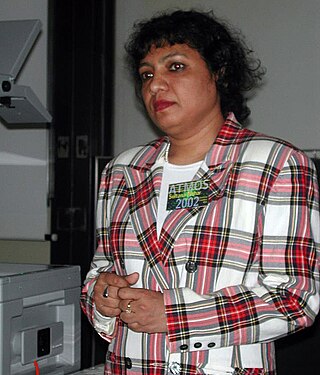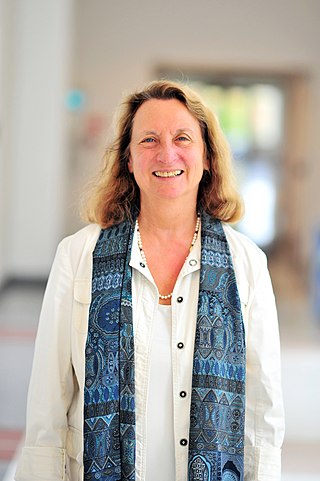Related Research Articles
The plasma window is a technology that fills a volume of space with plasma confined by a magnetic field. With current technology, this volume is quite small and the plasma is generated as a flat plane inside a cylindrical space.

A photoionization mode is a mode of interaction between a laser beam and matter involving photoionization.
Isaac David Abella was a Canadian physicist who was a professor at the University of Chicago. He specialized in laser physics, quantum optics, and spectroscopy. Isaac was the cousin of Irving Abella.

Plasma is one of four fundamental states of matter characterized by the presence of a significant portion of charged particles in any combination of ions or electrons. It is the most abundant form of ordinary matter in the universe, mostly in stars, but also dominating the rarefied intracluster medium and intergalactic medium. Plasma can be artificially generated, for example, by heating a neutral gas or subjecting it to a strong electromagnetic field.
The Laboratoire Plasma et Conversion d'Energie, Toulouse is a Centre National de la Recherche Scientifique (CNRS) laboratory, operated jointly by the CNRS, the University of Toulouse and the Institut National Polytechnique of Toulouse. This facility is located near other important higher education facilities in Toulouse, France: the Paul Sabatier University, SUPAERO, the ENAC, the INSA, as well as other research centers.

Sultana Nurun Nahar is a Bangladeshi-American physicist. She is a research scientist in the Department of Astronomy at Ohio State University.
The index of physics articles is split into multiple pages due to its size.

Margaret Galland Kivelson is an American space physicist, planetary scientist, and distinguished professor emerita of space physics at the University of California, Los Angeles. From 2010 to the present, concurrent with her appointment at UCLA, Kivelson has been a research scientist and scholar at the University of Michigan. Her primary research interests include the magnetospheres of Earth, Jupiter, and Saturn.

Elaine Surick Oran is an American physical scientist and is considered a world authority on numerical methods for large-scale simulation of physical systems. She has pioneered computational technology to solve complex reactive flow problems, unifying concepts from science, mathematics, engineering, and computer science in a new methodology. An incredibly diverse range of phenomena can be modeled and better understood using her techniques for numerical simulation of fluid flows, ranging from the tightly grouped movements of fish in Earth's oceans to the explosions of far-flung supernovae in space. Her work has contributed significantly to the advancement of the engineering profession.

Heather Lewandowski is a professor of physics at the University of Colorado Boulder. She looks to understand the quantum mechanical processes in making chemical bonds. She uses time-varying inhomogeneous electric fields to achieve supersonic cooling. She also studies how students learn experimental skills in instructional physics labs and help to improve student learning in these environments. She is a Fellow of the American Physical Society.
Félicie Albert is a French and American physicist working on laser plasma accelerators. She is the deputy director for the Center for High Energy Density Science at Lawrence Livermore National Laboratory (LLNL) and staff scientist at the National Ignition Facility and Photon Science Directorate and the Joint High Energy Density Sciences organization.
Phillip A. Sprangle is an American physicist who specializes in the applications of plasma physics. He is known for his work involving the propagation of high-intensity laser beams in the atmosphere, the interaction of ultra-short laser pulses from high-power lasers with matter, nonlinear optics and nonlinear plasma physics, free electron lasers, and lasers in particle acceleration.
Richard R. Freeman was an American physicist, academic and researcher. He was an affiliated professor of physics at the University of Washington, a distinguished emeritus professor of mathematical and physical science at Ohio State University, and an emeritus Edward Teller Professor of Applied Science at University of California, Davis.
Anke Lindner is a German physicist known for her work on Non-Newtonian fluids and viscous fingering, especially in complex suspensions. She is a professor at Paris Cité University, formerly called Paris Diderot University.

Tammy Ma is an American plasma physicist who works on inertial confinement fusion at the Lawrence Livermore National Laboratory.
Denise Hinkel is a plasma physicist at Lawrence Livermore National Laboratory.
Corinna Susan Kollath is a Scottish-born German theoretical and computational physicist whose research involves ultracold gases, the many-body problem, and out-of-equilibrium low dimensional correlated systems in quantum mechanics. She is a professor at the University of Bonn
Chun Chia Lin is an American physicist.
Marthe Bacal Verney (1931–2024) was a plasma physicist known for her research on ion sources, applications of ion sources in neutral beam injection, and diagnostics for ion beams. Originally from Romania, and educated in Russia and France, she spent much of her career in France.
References
- 1 2 Pitchford, Leanne Carolyn (1976), Development of a Quantitative Model for High Power Pulsed Lasers (Doctoral dissertation), University of Texas at Dallas, Bibcode:1976PhDT........62P, ProQuest 302834838
- ↑ GREPHE: Groupe de Recherche Energetique, Plasma et Hors Equilibre, Laplace, University of Toulouse, retrieved 2023-07-13; see section "membres du groupe", where Pitchford is listed among the "emérites"
- 1 2 3 4 5 2018 Will Allis Prize for the Study of Ionized Gases Recipient, American Physical Society, retrieved 2023-07-13
- ↑ "L. Pitchford", IEEE Xplore, IEEE, retrieved 2023-07-13
- ↑ Williams, Dean (7 August 2015), "Von Engel and Franklin Prize 2015", JPhys+: News and views from the Journal of Physics series, Institute of Physics, retrieved 2023-07-13
- ↑ "Fellows nominated in 2019 by the Forum on Industrial & Applied Physics", APS Fellows archive, American Physical Society, retrieved 2023-07-13